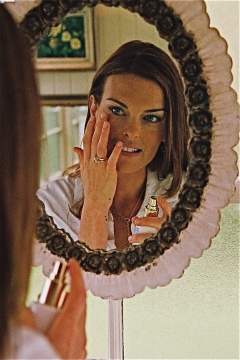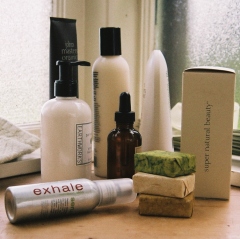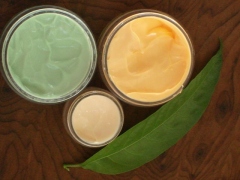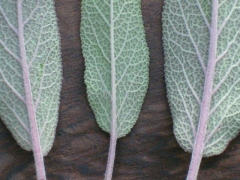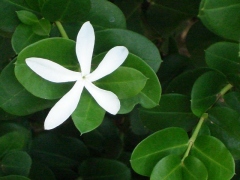12 Steps to Green your Beauty/Grooming Routine
1. Be a Label Maven - Read Labels
Reading labels is the single most effective tool to reveal just what's in the products we slather, lather and anoint our bodies with, and just how natural, eco-friendly and human-safe they are. While brazen statements like "natural" and allusion to "botanicals" might occupy real estate on the front of labels, the ingredient list is the prime verbiage to pay attention to [avoid applying a chemical cocktail]. Companies that formulate clean, green products will generally tell it like it is, defining and disclosing ingredients clearly without shrouding them in vague terms. The bottom line is that if you can't identify ingredients, either because of their chemical terminology or because they are ambiguous, you might want to reconsider using the product on any of the precious surfaces of your body.
2. Keep Preservatives in Check - go paraben-free
Preservative ingredients are key players to keep personal care (PC) products fresh and shelf-stable [from the detriments of light, heat, oxygen, and bacteria]. Synthetic chemical preservatives like the paraben posse (butyl-, ethyl-, methyl-, and propyl-) have long been used in just about every kind of PC product - they're cheap, and in a vacuum, parabens are very effective preservatives. However, parabens are toxic by nature, given that they're toxic to bacteria and microbes to keep a product from spoiling and may have a casual link to some pretty dodgy side effects. Since paraben preservatives are generally used in minute amounts, some beg the question, what's the big deal? Well, debatable concerns about their rampant use has hit the radar backed by a growing number of reputable studies linking parabens to acute and chronic health hazards from skin allergies, irritation and reactions (1, 2, 3) to endocrine disruption, hormone mimicry (4, 5, 6, 7), developmental and reproductive toxicity (8, 9, 10) and even cancer (11, 12, 13, 14). While the jury is out on just how "safe" parabens are, the call to cull paraben-free products is a widely available option. Look for products with natural preservatives, like antioxidant-rich like vitamin E, essential oils and grapefruit seed extract, to name a few, which are gaining ground for excellent efficacy without the dangerous health hazards.
3. Go Petroleum Free [Plants over Petroleum]
Petroleum-derived ingredients, which are standard in many conventional PC products are none too healthy for human skin and take a complex toll on the environment from extraction through manufacturing, use and disposal. Ingredients like mineral oil, propylene glycol, polyethylene glycols (PEGs), plastic in sanitary pads, paraffin, benzene and coal tar dyes are a few examples of the breadth of regularly used petrochemical ingredients in personal care products. Petro-based chemicals won't biodegrade anytime soon and are linked with a sliding scale of health concerns from instigating irritation and contact dermatitis to organ damage and as suspect carcinogens. Plants trump petroleum in every green category from non-toxic renewable rigor to superior and pleasurable performance. Choose plant-based personal products and do yourself and the planet a world of good.
4. Underarm Awareness - avoid aluminum
Aluminum is a precarious compound used in antiperspirants as an active ingredient to tamp down the flow of sweat. Aluminum reacts with the natural salts in our sweat to form a little gel plug to block pores and arrest perspiration, but the reaction doesn't seem to stop there. While both sides of the aisle debate whether there's a direct link between aluminum, and breast cancer (15, 16), there's pretty keen evidence that there is, indeed, a relationship (17). Aluminum-based compounds are known to mimic estrogen hormones (18) and are competent to bind to and block hormone receptors. This is not a good thing for breasts. Also known as a neurotoxin (19, 20, 21) that is quite capable of crossing the blood-brain barrier (22, 23), aluminum in deodorant has also been in the seat of contention with serious concerns related to Alzheimer's disease for over 20 years. If the jury is out, you won't need to take the risk by electing natural paraben-free deodorants based on mineral and botanical might to bust odor-causing bacteria.
5. Pearly White Promises
Get gorgeous pearly whites the natural way and smile with keen, green confidence. Choose squeaky clean toothpaste sans synthetic, sudsing SLS, which may be contaminated with nasty byproducts such as 1,4-dioxane and nitrosamines (24) during processing (both probable carcinogens (25, 26, 27, 28) and may enhance tissue penetration (29) of other chemicals in toothpaste formulas. Opt out of potentially poisonous fluoride (30) in favor of kissing-friendly botanicals and natural whitening gentle abrasives. Side step synthetic dyes, artificial sweeteners and flavor enhancers and instead choose toothpastes with a naturally occurring fresh taste.
6. Frank Fragrances
Not all fragrances are created equal. Natural fragrances from plants and essential oils are a keen choice for clean scents and seductive smells without the serious hazards associated with synthetically fragranced counterparts. The definition of "fragrance" is one of the most vague in personal care products - the trouble is that on a product label fragrance can mean just about anything and may contain as few as 10 chemicals or as many has hundreds. Ninety-five percent of chemicals used in fragrances are synthetic petrochemicals (31), including phthalates, which are used as solvents to "fix" fragrance to make scents stick around longer. Independent studies by public health organizations reveal that about 70 percent of personal care products contain phthalates (32, 33), which is a serious concern given that phthalates can bioaccumulate in human tissue and are linked with cancer (34, 35), endocrine disruption (36, 37), neuro-disorders (38), toxicity of the brain, kidneys, liver and lungs (39, 40, 41), and birth defects (42). They're also toxic in the environment (43). Any product with synthetic fragrances, or undisclosed fragrances may contain phthalates. Look for products with natural fragrances from plants and essential oils and those that disclose the sources of the fragrance to be green and smell clean.
7. Body Moisturizers to Nourish Naturally
Choosing a clean, plant-based body moisturizer is good for your skin and kind to the earth. Natural moisturizers made from plant-based and botanical ingredients are made from nontoxic, renewable materials that will nourish and moisturize your skin naturally as opposed to petroleum-derived products that extract an ecological toll and may contain ingredients you don't want you skin to absorb. Look for moisturizers with an ingredient list you can understand and boast botanical fragrances. For planetary and personal sake, opt for those that are free of paraben preservatives, suspect synthetics, undisclosed fake fragrances and chemical colorants. Be merry and moisturize with good green stuff.
8. Tame Tresses Naturally - Plant-based Hair Care
Life is too short not to have great hair naturally. Whether maintaining your mop with minimal muster or going for glamorous pomp and pizzazz, there's a new generation of clean, green hair care products to give lifeless locks luster and eco-chic style. Reading ingredient lists is the primary operative to effectively choose human-safe, planet-friendly hair care products. Look for those that are free of synthetic, sudsy SLS and SLES, petrochemical performers, paraben preservatives, and artificial fragrances and colorants. Plant-based hair care products are better for your hair, scalp and skin and won't run amok in the ecosystem beyond the drain. Being green doesn't mean living in a perpetual "bad hair day", it simply means scouting for the good stuff [to tame you mane and think beyond the drain].
9. Conscious Cosmetics - be a make-up maverick
Cosmetic makeup has a long and scandalous history. While ladies and gents have given up dusting their faces with powders made of lead and rouge made from ore of mercury, or painting dramatic eyes with dark kohl made from neurotoxic lead all of which was in vogue from Roman and Egyptian times through the Victorian era, today's cosmetics have become a veritable laboratory loaded with modernized chemicals. The crazy fact is that very few regulations exist for makeup formulas. The chemicals, dyes, colorants, fragrances and preservatives found in conventional cosmetics are deeply disturbing. It's crazy because facial skin is some of the most delicate and permeable skin on our bodies, and makeup is typically worn for hours on end. As with all else, the river of ingredients in makeup diverges into either a synthetic (chemical) or natural (plant or mineral based) tributary. Suffice to say, there's no need to walk around with a bare face - there's a bouquet of fabulous, natural cosmetics that perform with flawless results for every nuance and need in the makeup arena. While I don't think I'm alone in thinking that less is more when it comes to makeup, choosing natural cosmetics is an absolute necessity for life-long beauty.
10. Cruelty-free Concerns
You don't have to be a tree hugger to agree that animal testing is uncouth and unnecessary. Look for products that have the "leaping bunny" stamp of not-animal-tested approval, which are verified by the Humane Cosmetics Standard (HCS), to be sure they are cruelty-free.
11. Sun Sanity - SPF Safety
While humans need a healthy dose of sun to assimilate valuable vitamin D and foster happy spirits, UV rays from sunlight damage collagen and lead to accelerated aging of the skin. Protect your skin with sunscreens that offer broad-spectrum physical protection using titanium dioxide and zinc oxide, both of which are effective on the skin's surface but are too large to be absorbed. Look for products that are free of chemical preservatives and sunscreen chemicals, which though may prove effective for UV protection, are easily absorbed through the skin with questionable consequences. Mineral powders are the new generation of safe, effective SPF, offering physical protection from both full-spectrum UV rays and other environmental pollutants while still allowing your skin to breathe.
12. Feminine Product Protocol
Whether you greet your monthly flow with celebration, dread or indifference, treat your precious tissue and the planet right and dodge the dangers of dioxins by electing natural feminine products that are whitened without chlorine. Look for tampons made from 100% organic cotton to eliminate the risks posed by synthetic materials and sanitary pads made from plant-based biodegradable materials. Take the next step towards reducing waste completely (and save cash in the process) with a reusable menstrual cup made from silicone.
Sources:
(1) NTP (National Toxicology Program), "Butylparaben, Final Review of Toxicological Literature", CAS No. 94-26-8. ntp.niehs.nih.gov/files/Butylparaben.pdf
(2) Journal of the American Medical Association, " Paraben Allergy," Nagel, J., et al., (1977) Vol. 237 (15). jama.ama-assn.org/cgi/content/abstract/237/15/1594
(3) Journal of the American Medical Association, " Paraben Allergy," Nagel, J., et al., (1977) Vol. 237 (15). jama.ama-assn.org/cgi/content/abstract/237/15/1594
(4) NTP (National Toxicology Program), "Butylparaben, Final Review of Toxicological Literature", CAS No. 94-26-8. ntp.niehs.nih.gov/files/Butylparaben.pdf
(5) Toxicology and Applied Pharmacology, "Some alkyl hydroxy benzoate preservatives (parabens) are estrogenic," Routledge, E., et al., (1998). Vol. 153(1), p. 12-19.
(6) Toxicology and Applied Pharmacology, "Some alkyl hydroxy benzoate preservatives (parabens) are estrogenic," Routledge, E., et al., (1998). Vol. 153(1), p. 12-19
(7) Toxicology and Applied Pharmacology, "Some alkyl hydroxy benzoate preservatives (parabens) are estrogenic," Routledge, E., et al., (1998). Vol. 153(1), p. 12-19
(8) NCIB (National Center for Biotechnology Information) "Effects of butyl paraben on the male reproductive system in mice, "Oishi S., Arch Toxicol. 2002a; 76:423-429. www.ncbi.nlm.nih.gov/entrez/query.fcgi
(9) Environmental Health Perspectives, "Effect of neonatal exposure to estrogenic compounds on development of the ducts of rat testis through puberty to adulthood," Fisher, J., et al., (1999) Vol. 107, p. 397-405
(10) Food Chem Toxicol, "Effects of propyl paraben on the male reproductive system," Oishi S., (2002) Vol. 40(12) p. 1807-13
(11) Journal of Applied Toxicology, "Concentration of Parabens in Human Breast Tumors", Darbre, PhD., et al., (2004) Vol. 24, p. 5-13
(12) Journal of Applied Toxicology, "Significance of the detection of esters of p-hydroxybenzoic acid (parabens) in human breast tumours," Harvey, P., and Everett, D., (2004), Vol. 24, p. 1-4
(13) Journal of Applied Toxicology, "Concentrations of parabens in human breast tumors," Darbre, P., et al., (2004) Vol. 25, p. 5-13
(14) Journal of Applied Toxicology, "Significance of the detection of esters of p-hydroxybenzoic acid (parabens) in human breast tumours," Harvey, P., and Everett, D., (2004), Vol. 24, p. 1-4
(15) American Journal of Medicine, "Aluminum in Antiperspirants: More than just skin deep," Vol. 117(12), pp. 969-970
(16) Journal of Inorganic Biochemistry, "Aluminum, antiperspirants and breast cancer," Darbre, PD, 2005, Vol. 99(9), pp. 1912-1929
(17) National Breast Cancer Coalition, "No Proven Link Between Antiperspirant Use and Breast Cancer," 2005. www.natlbcc.org/bin/index.asp
(18) Journal of Inorganic Biochemistry, "Aluminum, antiperspirants and breast cancer," Darbre, PD, 2005, Vol. 99(9), pp. 1912-1929
(19) New England Journal of Medicine, "Neurotoxicity in preterm infants receiving intravenous-feeding solution," Bishop, N. J., et al., 1997, Vol. 336(22), pp. 1557-1561
(20) Department of Health and Human Services, FDA (U.S. Food & Drug Administration), " 21 CFR Part 165," Docket No. 95N090203, 1995. www.cfsan.fda.gov/~lrd/n095-327.txt
(21) Pediatric Nephrology, "Aluminum Toxicity in Childhood," Sedman, A., 1992, Vol. 6(4). www.springerlink.com/content/v5h1446t58x26655/
(22) Biological Trace Element Research, "Aluminum transfer as glutamate complex through blood-brain barrier. Possible implication in dialysis encephalopathy," Deloncle, R., et al., 1990, Vol. 25(1), pp. 39-45. www.ncbi.nlm.nih.gov/sites/entrez
(23) Journal of Alzheimer's Disease, "Blood-brain barrier flux of aluminum, manganese, iron and other metals suspected to contribute to metal-induced neurodegeneration," Yokel, R., 2006, Vol.10, pp. 223-253. www.mc.uky.edu/pharmacy/faculty/files/jad.pdf
(24) Journal of AOAC International, "Occurrence of 1,4-Dioxane in Cosmetic Raw Materials and Finished Cosmetic Products," Roderick E., et al., 2001, Vol. 84(3), p. 666-670. www.atypon-link.com/AOAC/doi/abs/10.5555/jaoi.2001.84.3.666
(25) U.S. Environmental Protection Agency, "1,4-Dioxane (1,4-Diethyleneoxide)," Hazard Summary, Created in April 1992; Revised in January 2000. www.epa.gov/ttn/atw/hlthef/dioxane.html
(26) Breast Cancer Fund, "Cancer-causing Chemical found in Children's Bath Products," 2007. www.breastcancerfund.org/site/pp.asp
(27), (28) NIHES (National Institue of Health and Environmental Sciences), "N-Nitrosodiethanolamine, CAS No. 1116-54-7, Reasonably anticipated to be a human carcinogen," Second Annual Report on Carcinogens, 1981. ntp.niehs.nih.gov/ntp/roc/eleventh/profiles/s126nitr.pdf
(29) MCP (Molecular and Cellular Proteomics), "Surfactant Sodium Lauryl Sulfate Enhances Skin Vaccination: Molecular Characterization via A Novel Technique Using Ultrafiltration Capillaries and Mass Spectrometric Proteomics," Huang, C., et al., 2005. www.mcponline.org/cgi/reprint/M500259-MCP200v1.pdf
(30) ATSDR (Agency for Toxic Substances & Disease Registry), "Toxicological Profile for Fluorides, Hydrogen Fluoride and Fluorine," 1993, prepared by Clement International Corporation, Contact No. 205-88-0608. www.fluoridealert.org/ATSDR-Fluoride.pdf
(31) Report by the Committee on Science & Technology, "Neurotoxins: At Home and the Workplace," U.S. House of Representatives, Sept. 16, 1986. (Report 99-827)
(32) EWG, "Not Too Pretty - Phthalates, Beauty Products and the FDA," Houlihan, J., Brody, C., Schwan, B., 2002. www.safecosmetics.org/docUploads/NotTooPretty_r51.pdf
(33) Health Care Without Harm, "Aggregate Exposures to Phthalates in Humans," DiGangi, J. PhD, et al., 2002. www.nottoopretty.org/images/PhthalatesReportLong.pdf
(34) Teratogenesis, Carcinogenesis, and Mutagenesis, "Genotoxicity of di-butyl-phthalate and di-iso-butyl-phthalate in human lymphocytes and mucosal cells", Kleinsasser, N., et al., 2001, Vol.21, Issue 3, p. 189-196, Wiley-Liss Inc. www3.interscience.wiley.com/cgi-bin/abstract/78505490/ABSTRACT
(35) Official Journal of the American Academy of Pediatrics, " Pediatric Exposure and Potential Toxicity of Phthalate Plasticizers," Shea, K. and Committee on Environmental Health, 2003, Vol. 111, No. 6, p. 1467-1474. pediatrics.aappublications.org/cgi/content/full/111/6/1467
(36) NIEHS (National Institute of Environmental Health Services, "Endocrine Disruptors", 2006. www.niehs.nih.gov/oc/factsheets/pdf/endocrine.pdf
(37) CERHR (Center for the Evaluation of Risks to Human Development), "NPT Brief on the Potential Human Reproductive and Developmental Effects of Di(2-ethylhexyl) Phthalate (DEHP)," U.S. Department of Health, national Toxicology Program, Draft May 2006. cerhr.niehs.nih.gov/chemicals/dehp/DEHP%20Brief%20Draft1.pdf
(38) Institute of Public Health, Denmark & Department of Environmentla Health, Harvard School of Public Health, "Developmental neurotoxicity of industrial chemicals," Granjean,P., Landrigan, P., 2006. www.kevinleitch.co.uk/wp/wp-content/uploads/2006/11/chemicallist.pdf
(39) National Toxicology Program, "Chemical Information Profile for Diethyl Phthalate," CAS No. 84-66-2, 2006
(40) Health Care Without Harm, "Aggregate Exposures to Phthalates in Humans," DiGangi, J. PhD, et al., 2002. www.noharm.org/library/docs/Phthalate_Report.pdf
(41) American Journal of Industrial Medicine, "Health Risks posed by use of Di-2-ethylhexyl phthalate (DEHP)," Tickner, J., et al., 2001, Vol. 39(1), p. 100-111
(42) Toxicology & Applied Pharmacology, "Teratogenic phthalate esters and metabolites activate the nuclear receptors PPARs and induce differentiation of F9 cell," Lampen, A., et al., 2003, Vol. 188(1), p. 14-23
(43) Journal of Environmental Monitoring, "Survey of phthalate pollution in arable soils in China," Hu, X., et al., 2003, Vol. 5, p. 649-653. www.rsc.org/publishing/journals/EM/article.asp
Tagged: beauty good to know

